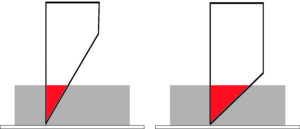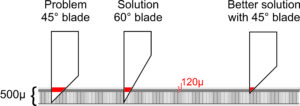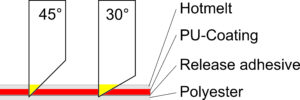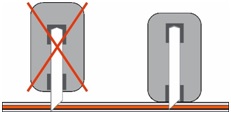For years, the market of the digital transfer printing has been growing and this has been partly at the expense of the traditional screen printing transfer. However, this also opens new possibilities and markets. Holger Beck, Sef’s area manager, explains more.
The entry hurdle is low, because with just a small investment in a plotter and heat press you can start your business. The potential problems, however, remain the same, and new functional fabrics are creating new ones.
In a multi-part series of articles I would like to help users to recognise potential problems and to develop solutions. In this first part I want to explain the process of cutting and weeding.
Normally cutting and weeding causes no problems. However, there are two problems that are well worth considering: thick films, such as flock film and thin, elastic flex films.

Thick films
The problem with thick films is that the knife gets trapped within the material and cannot turn or not turn easily. This results in creased corners and makes it difficult or even impossible to cut smaller motifs. The solution for this is a knife with a sharper angle at the tip. These are usually called flock knives. With 500µ flock is indeed a quite thick material.
This is certainly a simple solution for resolving the problem with flock. However, this is no longer the best solution. And this is because of Greenpeace. In their campaign against organostannic compounds in ship coatings Greenpeace discovered that these organostannic compounds are also used as a catalyst in hot-melt films. Since these catalysts are no longer used, the hot-melt films of flock are now less brittle and a bit more elastic. Therefore, the films are more difficult to cut with an obtuse-angled blade.
But do we have to cut through the entire 500µ of the flock film? Rather not. Only the hot-melt film and the flock adhesive must be cut.

They are insignificantly thicker than a normal flex film. Because of that, the best solution is to adjust the depth of the knife so that only what is really necessary will be cut. This also allows the cutting of flock films with a high flock density, such as VelCut Evo, more easily with a 45° standard knife than with a flock knife.
Thin, elastic films
The thinner and more elastic a flex film is, the more comfortable is the decorated garment to wear. However, it is also more difficult to cut the film. The film will tend to escape instead of being cut. You should use a rather flat knife in this instance.

The measurement in degrees is not always clear; for most knives the free angle α is indicated, but for some knives it is also the cutting angle β. If the cutting angle β is specified, then a 60o knife is a flat knife.

Depth of the knife
The adjustment of the knife depth is also important for thin and elastic films, such as FlexCut Advance. This is not only for the result but also for the durability of the plotter parts: knife holder and cutting bar.

If the knife stands out more than necessary from the knife holder, then the lever force that impacts on the bearing at the end of the knife is considerably higher. The bearing is worn out more quickly and will exhibit axial play.
Knife holder
When the knife holder has too much axial play, the knife will bend at every change of direction towards the side, instead of turning. This is the cause of typically fine and uncut areas at the corners, which will complicate the process of weeding or make it impossible. With brittle, thick films, this is not so noticeable, especially not when the carrier has a high adhesion. However, with thin and elastic films it is very noticeable. This is not a problem of the film but a problem of the knife holder. Some drops of oil in the bearing can help to reduce the axial play. Sometimes, however, it is necessary to invest in a new knife holder in order to make the weeding simpler and quicker.

OverCut
A further feature that helps prevent problems during the weeding process is to use the OverCut function of the plotter. If your older plotter does not have this function, an investment in a new plotter may pay for itself quickly. The better the cut, the quicker is the weeding.

Cutting speed
Many users tend to reduce the cutting speed continually lower, when finding out the correct cutting speed. This is certainly the correct approach with thicker and harder materials – craftspeople know: the thicker the board, the lower is the sawing speed. However, with thin and elastic films it is easier to cut them with higher speeds.
Weeding
Also for weeding, there are tricks to work more quickly. These may be self-evident, but for a beginner they can be helpful:
- Set a weeding frame around every text line so you can weed line by line.
- Remove first the inner parts of the letters so parts that may fall down will not stick on the polyester film.
- Weed from the left to the right; most of the letters are open to this side.
Sef film and vinyl products are available in the UK through Amaya Sales UK.
 Printwear & Promotion The Total Promotional Package
Printwear & Promotion The Total Promotional Package




